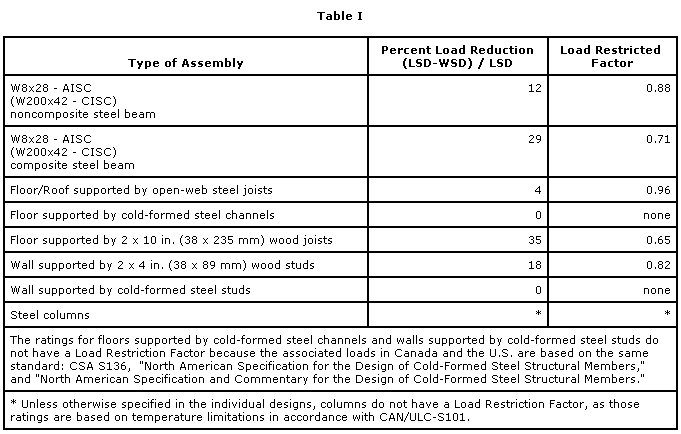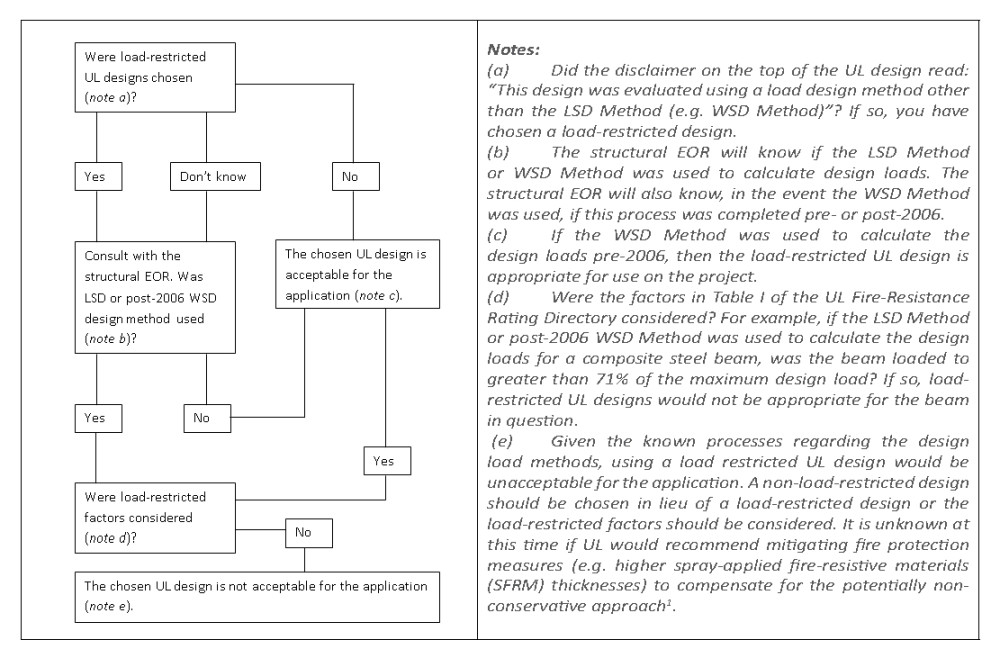
Evaluation and selection of design
If a project uses the LSD or the post-2006 WSD method to calculate design loads—either of which would yield the same result—the UL design with the above disclosure cannot be used except when the guidance at the front of the UL Fire-Resistance Rating Directory is considered. When the load restriction factors (see right) are applied to maximum design loads calculated under these design methods, a new load-restricted maximum design load is established in which load-restricted UL designs can be used. If the actual design load exceeds the new load-restricted maximum design load, a load-restricted UL design is not appropriate for the project and cannot be used.

The Directory further notes the EOR should be consulted whenever fire-resistive assemblies with load restrictions are selected for a project by the architect or contractor, because the latter two may lack adequate and accurate information for determining whether such a design can, in fact, be used. Thus, UL has assigned the responsibility for verifying that appropriate UL designs have been chosen to the EOR. That process calls for an open dialogue between architects and structural, engineers and should include the general guidelines found in Table 2 (Above).
Conclusion
The intent of this article is to point out the complexities involved in choosing an acceptable UL design for each specific application and to help the Engineer of Record (sometimes an architect or a structural engineer) make the right choice. The flowchart above is a helpful tool in evaluating the viability of the chosen solution. If questions remain following this analysis, it is advisable to consult a qualified industry professional, such as a structural engineer, a fire/life safety engineer, or a code consultant.
 Eric Montplaisir is a code consultant in the Boston office of AKF Group, a full service consulting engineering firm serving public and private sector clients across the United States and around the world. Eric has an impressive background in fire protection engineering and code consulting—including fire modeling services, atrium smoke modeling analysis, structural steel analysis, and code conformance reviews. He holds Master of Science in Fire Protection Engineering, and Bachelor of Science in Mechanical Engineering degrees, and is a Licensed Professional Engineer, Fire Protection, in Massachusetts. He is a Professional Member of the Society of Fire Protection Engineers (SFPE), and the National Fire Protection Association (NFPA). He can be reached at emontplaisir@akfgroup.com
Eric Montplaisir is a code consultant in the Boston office of AKF Group, a full service consulting engineering firm serving public and private sector clients across the United States and around the world. Eric has an impressive background in fire protection engineering and code consulting—including fire modeling services, atrium smoke modeling analysis, structural steel analysis, and code conformance reviews. He holds Master of Science in Fire Protection Engineering, and Bachelor of Science in Mechanical Engineering degrees, and is a Licensed Professional Engineer, Fire Protection, in Massachusetts. He is a Professional Member of the Society of Fire Protection Engineers (SFPE), and the National Fire Protection Association (NFPA). He can be reached at emontplaisir@akfgroup.com




